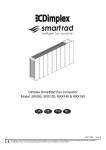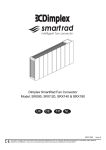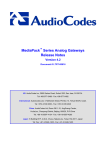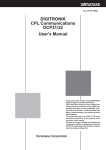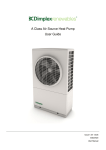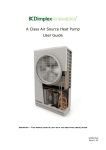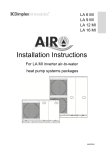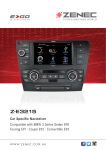Download pdf
Transcript
SmartRad Planning Manual Issue 1 – 15 April 2010 Dimplex SmartRad Fan Convector Models SRX80, SRX120, SRX140 & SRX180 Applies to models with White Glass, Black Glass and Metal facias SmartRad planning manual – Issue 1 – 15 April 2010 Contents 1 Introduction to the SmartRad ......................................................................................................... 4 2 Benefits of the SmartRad ................................................................................................................ 4 3 4 5 6 2.1.1 Smaller dimensions ......................................................................................................... 4 2.1.2 Low flow temperature .................................................................................................... 4 2.1.3 Lower Water content ...................................................................................................... 5 2.1.4 Rapid heat up .................................................................................................................. 5 2.1.5 Fast Reacting ................................................................................................................... 5 2.1.6 Less stratification ............................................................................................................ 5 2.1.7 Low surface temperature................................................................................................ 6 SmartRad Specification ................................................................................................................... 7 3.1 Technical and performance data ............................................................................................ 7 3.2 Electrical specification ............................................................................................................ 8 3.3 Hydraulic connection .............................................................................................................. 8 3.4 Pressure Losses ....................................................................................................................... 9 3.5 SRX Outputs (Watts) ............................................................................................................. 10 3.6 Output adjustment for different flow rates .......................................................................... 11 Accessories .................................................................................................................................... 11 4.1 Filter set SRX FS ..................................................................................................................... 11 4.2 Plug in timers ........................................................................................................................ 11 Installation Considerations ........................................................................................................... 12 5.1 SmartRad positioning ............................................................................................................ 12 5.2 System Balancing .................................................................................................................. 12 5.3 Wall Mounting ...................................................................................................................... 12 5.4 Water Connection ................................................................................................................. 13 5.5 Corrosion inhibitors .............................................................................................................. 14 5.6 Electrical Connection ............................................................................................................ 14 Typical applications ....................................................................................................................... 15 6.1 Whole house ......................................................................................................................... 15 6.2 SmartRads mixed with Radiators .......................................................................................... 15 6.3 SmartRads mixed with under floor heating .......................................................................... 15 6.4 Ground Source heat pumps .................................................................................................. 15 Page 2 of 19 SmartRad planning manual – Issue 1 – 15 April 2010 Controls and Control strategies ............................................................................................................ 16 7 6.5 Mixed SmartRad and Radiator circuits ................................................................................. 16 6.6 Boiler interlock ...................................................................................................................... 16 6.7 SmartRad controls................................................................................................................. 16 6.8 Central system control .......................................................................................................... 16 6.9 Individual SmartRad control Plug in controllers ................................................................... 17 6.10 Spring and autumn operation ............................................................................................... 17 6.11 Summer operation ................................................................................................................ 17 6.12 Pump optimisation ................................................................................................................ 17 Designing the system for Maximum Efficiency ............................................................................. 18 7.1 Choosing a Mean Water Temperature (MWT) ..................................................................... 18 7.1.1 Suggested MWT ............................................................................................................ 18 7.1.2 Air off temperatures ..................................................................................................... 18 7.2 Weather compensation ........................................................................................................ 18 Page 3 of 19 SmartRad planning manual – Issue 1 – 15 April 2010 1 Introduction to the SmartRad The SmartRad is a stylish and modern alternative that out performs traditional radiators. At the heart of the SmartRad is a heat exchanger with a large surface area, which allows effective transfer of heat into the room even at low flow temperatures. To increase the amount of heat output there is an energy efficient fan which forces air over the heat exchanger. By being able to give a decent heat output at low flow temperatures, the SmartRad makes it even more viable to install heat pumps when refurbishing a property. 2 Benefits of the SmartRad Thanks to the heat exchanger and fan the increased heat output means that the SmartRad takes up less wall space compared to a standard radiator when operating under the same conditions. The following examples demonstrate the benefits of the SmartRad over traditional radiators. 2.1.1 Smaller dimensions A Radiator with dimensions of 530x911mm would need to have a Mean Water Temperature (MWT) of 73⁰C to give an output of 1kW whilst the SmartRad would only need a MWT of 40⁰C to give the same 1kW output. This means the system can be run at significantly lower flow temperature which will give significant savings in system efficiency. 2.1.2 Low flow temperature As shown in Figure 1 a standard radiator operating at a flow temperature of 40⁰C would need to measure 530x3128mm whilst Figure 2 shows that the SmartRad would only need to be 530x911mm – that is over 3½ times smaller. Therefore, by using the SmartRad it becomes practical to fit the product into a room and still operate at lower flow temperatures. Page 4 of 19 SmartRad planning manual – Issue 1 – 15 April 2010 . Figure 1: Radiator sizes based upon a “Double convection” design with an output of 1537W Figure 2: SmartRad size based upon fan speed 2 setting with an output of 1537W. 2.1.3 Lower Water content The SmartRad contains only a fraction of the water compared to a traditional radiator. A traditional 1kW radiator operating at a flow temperature of 73⁰C could contain up to 35 litres of water, where as the SRX180 gives a 1kW output when operating at only 40⁰C but contains only 0.6 litres – that is over 50 times less water. 2.1.4 Rapid heat up The low water content makes the SmartRad highly reactive, when the heating demand increases the heat pump only has to heat a small volume of water to 40⁰C. However with a radiator the boiler would have to heat the 35 Litres of water to 73⁰C. 2.1.5 Fast Reacting The low water content is also beneficial if the heating demand is suddenly decreased if for example there is suddenly a solar gain. With a radiator the large thermal mass will stubbornly keep emitting heat even though the room is up to temperature, however with a SmartRad the fan will modulate its speed down and the low thermal mass will quickly cool down meaning that the room is not over heated. 2.1.6 Less stratification With a traditional radiator, the high water flow temperature means that the air off temperatures is high causing a ‘chimney’ effect as the hot air rushes to the ceiling but leaving the floor area cold. The air in the region around the thermostat is at the correct temperature but the average room temperature is in fact higher. A lot of heat is lost into the ceiling and though the upper part of the walls. Page 5 of 19 SmartRad planning manual – Issue 1 – 15 April 2010 With the SmartRad the lower water flow temperatures and increased mixing of the air by the fan mean that there is less temperature stratification, meaning that the average room temperature is in fact lower, meaning there is less heat loss to the ceiling and upper walls. The lower heat loss translates into lower heating bills and a more comfortable climate for the end user. 2.1.7 Low surface temperature Due to the heat exchanger being installed inside the cover it is possible to pass high temperature water though the SmartRad without the casing getting above 43⁰C. This means that the product could replace a standard high temperature radiator in places such as Nurseries and Care homes. Please note that full testing and approvals have not been competed yet. Page 6 of 19 SmartRad planning manual – Issue 1 – 15 April 2010 3 SmartRad Specification 3.1 Technical and performance data Fan Speed SRX080 SRX120 SRX140 SRX180 3 25-27 43-47 56-60 50-53 2 19-20 29-32 36-40 33-35 1 16-17 20-22 24-26 23-24 3 228 345 410 540 2 125 190 225 300 1 60 100 120 160 3 36 36 36 36 2 29 29 29 29 1 26 26 26 26 Water Content (l) 0.31 0.43 0.48 0.60 Length (mm) 503 670 740 911 Height (mm) 530 530 530 530 Depth (mm) 145 145 145 145 Fan Power Consumption (W) 3 Air Flow rate (m /h) Sound Level @ 1m dB(A) Installed weight (kg) – White metal front Installed weight (kg) – White glass front Not currently available at time of print. Installed weight (kg) – Black glass front Installation wall mounted Water protection of housing IP X0 Front Panel White metal front White Glass front Black Glass front Rear Panel Metal Approvals and certification CE declaration of conformity Conforms to EN 55014, EN 61000-3-2, EN 61000-3-3 Page 7 of 19 SmartRad planning manual – Issue 1 – 15 April 2010 3.2 Electrical specification Dimplex product name SRX080 SRX120 Nominal voltage (V) SRX140 SRX180 ∼ 230-240 Fuse rating (A) 3A Power Cable 4 core cable each with cross section of 0.75mm2, (live, neutral, earth and black wire for “pilot wire function”) usable length 1m, Electrical Power Consumption (W) 3A 3A 3A Speed 3 25-27 43-47 56-60 50-53 Speed 2 19-20 29-32 36-40 33-35 Speed 1 16-17 20-22 24-26 23-24 PCB only 1 1 1 1 3.3 Hydraulic connection Flow and return pipes 15mm copper pipes 50mm between middle of flow and return pipes Air bleed valve Air bleed valve on the top of the heat exchanger Typical flow rate (l/h) Typical 150l/h (can range from 100 l/h to 450 l/h ) Page 8 of 19 SmartRad planning manual – Issue 1 – 15 April 2010 3.4 Pressure Losses 18 16 Pressure Drop kPa 14 12 10 SRX080 SRX120 8 SRX140 6 SRX180 4 2 0 0 100 200 300 400 500 Flow Rate l/h Figure 3: Pressure losses and various flow rates Note: these pressure drops are only indicative. Each of the SmartRads have a different heat exchanger and therefore a different pressure. Figure 3 will be updated with the correct information when it is available. Page 9 of 19 SmartRad planning manual – Issue 1 – 15 April 2010 3.5 SRX Outputs (Watts) Inlet air temperature of 20⁰C and a water flow rate of 150 l/h Speed 3 Speed 2 Speed 1 Mean Water Temp ⁰C SRX080 SRX120 SRX140 SRX180 30 33 35 38 40 43 45 48 50 53 55 58 60 63 65 30 33 35 38 40 43 45 48 50 53 55 58 60 63 65 30 33 35 38 40 43 45 48 50 53 55 58 60 63 65 485 613 741 869 996 1124 1252 1380 1508 1635 1763 1891 2019 2147 2274 314 394 474 554 634 714 794 874 954 1034 1114 1194 1274 1354 1434 163 204 245 286 327 368 409 450 491 532 573 614 655 696 737 730 923 1115 1308 1500 1693 1885 2078 2270 2463 2655 2848 3041 3233 3426 401 521 640 759 878 997 1117 1236 1355 1474 1593 1713 1832 1951 2070 271 339 408 476 545 613 682 750 819 887 956 1024 1093 1161 1230 854 1079 1304 1530 1755 1980 2206 2431 2656 2882 3107 3332 3558 3783 4008 551 693 835 977 1119 1261 1403 1545 1687 1829 1971 2113 2255 2397 2539 323 405 487 569 650 732 814 896 977 1059 1141 1223 1305 1386 1468 1088 1375 1662 1949 2236 2523 2810 3097 3384 3671 3958 4245 4532 4819 5106 718 903 1088 1273 1457 1642 1827 2012 2197 2382 2567 2752 2936 3121 3306 423 530 637 745 852 959 1067 1174 1281 1389 1496 1603 1711 1818 1925 Page 10 of 19 SmartRad planning manual – Issue 1 – 15 April 2010 3.6 Output adjustment for different flow rates The output of the SmartRad is affected by the flow rate of water though the heat exchanger even if the Mean water temperature remains the same. The performance of the heat exchanger changes with flow rate due to increased heat transfer when the flow becomes more turbulent. For most instances 150l/h is the most suitable however a conversion factor can be used to adjust the heat output for different flow rates. Flow Rate l/h Adjustment Factor 50 100 150 200 250 300 350 400 450 0.87 0.93 1.00 1.04 1.06 1.09 1.10 1.10 1.10 4 Accessories 4.1 Filter set SRX FS Filter set can be clipped to the air inlet grill of the SmartRad. The filter is easily cuttable in order to fit all four sizes. The filter will slightly restrict the air flow meaning that the heat output will be slightly reduced. Dimensions of unit (W x H x D) mm Factor to calculate the power output reduction This information is not currently available. Please speak to your Dimplex representative for more information. Factor to calculate the air flow reduction 4.2 Plug in timers RX24Ti 24 hour programmable timer allowing each SmartRad to be configured to its own individual time program RXRBTi Electronic runback timer ideal for controlling running costs allowing the heater to only operate for a set period each time the controller is activated. Page 11 of 19 SmartRad planning manual – Issue 1 – 15 April 2010 5 Installation Considerations 5.1 SmartRad positioning In many instances the position of the SmartRad will already be dictated by the design of the room. Consideration must however be given to avoid: • • • • Fixing the product near curtains or other materials that are light weight and could be moved in the air current created by the fan. Installation in an environment where dirt, dust or pet hair could be sucked into the product and block the air flow. Installation immediately above or below a fixed socket outlet or connection box. In a location where the risk of water entering the product is possible for example bath rooms and kitchens. 5.2 System Balancing It is essential that there is adequate flow through each of the SmartRads. Balancing valves are not supplied with the product. 5.3 Wall Mounting The appliance should be securely mounted to the wall to minimise the possibility of noise transmission. Model SRX080 SRX120 SRX140 SRX180 A 503 670 740 911 B 324 492 562 732 C 396 564 634 804 D 386 564 624 794 Figure 4: Product and installation dimensions Page 12 of 19 SmartRad planning manual – Issue 1 – 15 April 2010 5.4 Water Connection There are a number of different plumbing options which the installer can adapt depending on the project as shown in Figure 5. The inlet and outlet pipes on the heat exchanger are plain 15mm pipe. Note that on the left hand side of the product the pipes pass in front of each other but on the right hand side pass side by side as shown in Figure 6. Figure 5: Possible routes for piping Page 13 of 19 SmartRad planning manual – Issue 1 – 15 April 2010 Figure 6: Note the different orientation of the flow and return pipes on the LHS and RHS. 5.5 Corrosion inhibitors The use of anticorrosion inhibitors is permitted with SmartRad. A general rule is that SmartRad system should be given the same protection as a wet radiator system. 5.6 Electrical Connection The SmartRad requires a connection to the mains power supply via a junction box fixed close to the product. In addition to the Live, Neutral and Earth cables, the SmartRad has a ‘pilot wire’ and can be used with optional plug in modules to communicate between the heaters. If the black ‘pilot’ wire is not being used it should be isolated in accordance with IEE wiring regulations. When the pilot wire is switching to set back it becomes energised at 240V although at a low current. Where pilot wires are installed separately from the heater circuitry they should be protected, double insulated and carry their own integral earth continuity conductor. For more information see the “Electrical Specification” . Page 14 of 19 SmartRad planning manual – Issue 1 – 15 April 2010 6 Typical applications The SmartRad is highly versatile; it can be used in conjunction with radiators or in conjunction with under floor heating. In all cases it is important to ensure that there is always an adequate flow of hot water at the correct temperature through the SmartRad throughout the entire heating season. In a domestic installation is typical to have all the heat emitters sized based upon the same mean water temperature. 6.1 Whole house SmartRads are ideal if the installer is aiming to reduce the flow temperature as low as possible, but it is not practical to install under floor. 6.2 SmartRads mixed with Radiators It is possible to combine standard radiators and SmartRads in the same installation. This is particularly common if the radiators in some rooms are too large or the number of radiators in each of the rooms needs to be reduced for aesthetic reasons. Special care needs to be taken to ensure that there is the correct flow rate through the radiators and SmartRads. 6.3 SmartRads mixed with under floor heating Under floor heating typically operates at low flow temperatures to maximise the efficiency of the heat pump of boiler. In many houses it is not practical to install under floor heating upstairs. If the installer wanted to install radiators upstairs it would be necessary to increase the flow temperature in order to get enough heat out of the radiators, this would mean that a second heating circuit would have to be installed and the temperature mixed down to make it cool enough for the under floor. By installing the SmartRads upstairs, there is no need to install a second heating circuit as the SmartRads can operate at the same temperature as the under floor system. Typical MWT should be higher than 40⁰C to prevent air off temperature from the SmartRad feeling too cold. 6.4 Ground Source heat pumps When installing the SmartRad extra care must be given to the running hours and sizing of the ground source heat pump. If the heat load is larger than expected the ground source heat pump will attempt to draw more heat from the ground than is available. This situation could occur if the SmartRad is sized to run on a low fan speed during the design stage but the heat load for the area is much higher in practice and the SmartRad is actually run on a higher fan speed drawing more heat from the system than expected. Page 15 of 19 SmartRad planning manual – Issue 1 – 15 April 2010 Controls and Control strategies Figure 7: SmartRad controls 6.5 Mixed SmartRad and Radiator circuits It is permissible to place radiators and SmartRads on the same heating system however the flow rates and MWT through each product should be considered to ensure that they give the desired output. I will be necessary to correctly balance the system. 6.6 Boiler interlock It is a requirement under the building regulations that all boilers should have interlock. i.e. a method of minimising system operation if there is no heating requirement. 6.7 SmartRad controls There is a temperature coil installed on the water coil that measures its temperature. The sensor prevents the fan from running if the MWT is less than 2⁰C warmer than room temperature or if the water is cooler than 14⁰C. If the water temperature is too low this will be indicated by the power light flashing. This feature has 3 benefits: • • Prevents the fan from running if there is no heat available from the heating system. This prevents cold air being blown around the room and also allows the SmartRad to be “disabled” centrally when there is no flow through the product by turning off the pump. Prevents the SmartRad from taking more heat from the system if the water temperature is lower than 14⁰C. This means that an air source heat pump will always have enough energy to perform a defrost. 6.8 Central system control The SmartRad is automatically disabled after a short time when there has been no flow through the product. This is achieved because when the circulating pump is switched off, the flow in the SmartRad will stop and its temperature starts to drop. The fan will be disabled once the water in the fan coil has cooled within 2⁰C of room temperature. As soon as the temperature rises above 2⁰C the fan will be enabled again. Page 16 of 19 SmartRad planning manual – Issue 1 – 15 April 2010 This means that the entire heating system can be enabled by a central timer clock which controls a circulating pump. The added advantage of SmartRad over radiators with TRVs is that the thermal mass of the SmartRad is much lower so therefore less heat is wasted when the system is turned off. 6.9 Individual SmartRad control Plug in controllers There may be times when it is desirable for some areas of the property to be heated and others not to be heated. This can be archived by having the central pump running and installing timers on the SmartRad in areas where no heating is required. With the plug in timers, there is still flow through the water coil, however, because the fan is not running the heat emitted is very low. In addition to control system already on the SmartRad controllers extra optional controllers can be fitted for increased control. This would be an ideal way to minimise running costs if not all parts of the building are occupied all of the time. 6.10 Spring and autumn operation When the weather starts improving, there will become times in the day when heating is no longer required. If weather compensation is enabled on the heat pump this will moderate the flow temperature to ensure that heating is only supplied when it is needed. During times when heating is not required for short periods it is best to leave the power on so that the SmartRad can control things correctly. The advantage of leaving the SmartRads turned on is that the plug in timer cassettes will retain their settings. 6.11 Summer operation When the weather has improved sufficiently so that the heat pump or boiler can be switched off or placed into “Summer mode”, the SmartRads can also be switched off. If the SmartRads are left in standby they have been designed to use very little power. Leaving them switched on during the summer has the added benefit that they will not lose their timer settings and no one will need to remember to turn them on again when the weather gets colder. 6.12 Pump optimisation For the majority of installations it is not recommended to use Pump Optimisation with the SmartRads although it may be appropriate in some instances. Some heat pump controllers such as the WPM 2006/7 give an option to switch off the circulating pumps if the return temperature has been met for a set period of time. The system then assumes that no heating is required and therefore can switch off the circuiting pumps. The controller will activate the pumps periodically to check the system temperature. Whilst pump optimisation could reduce the running time of the pump, if there is a heating demand whilst the pump is turned off the SmartRad will be unable to communicate this demand and the room will not be heated. Page 17 of 19 SmartRad planning manual – Issue 1 – 15 April 2010 7 Designing the system for Maximum Efficiency 7.1 Choosing a Mean Water Temperature (MWT) The MWT is the average between the inlet and outlet across the radiator. Feedback from customers is that a MWT of 40⁰C gives adequate air off temperatures. Some customers have indicated that an air off temperature with a MWT of 35⁰C is acceptable if they understand the benefits of maximising heat pump COP. 7.1.1 Suggested MWT Whilst there is no such thing as a typical installation, the following table suggests suitable flow temperature although the final choice is up to the installer. System heater Typical Mean Water temperature Water, Air and Ground source heat pumps Ideally low as possible. The lowest recommended temperature is 35⁰C with weather compensation fully activated and a design MWT of 40⁰C. Condensing boilers Below 55⁰C so that the flue gasses can condense all year round. As efficiency is not closely related to temperature it is best not to enable weather compensation since this will increase the SmartRad fan run time which has a small electrical consumption. Systems with efficiency not affected by flow temperature. The temperature does not matter so long as it falls within the product operating limits however care must be given to transmission losses between the radiators. Table 1: Summary of suggested MWT temperatures 7.1.2 Air off temperatures Decreasing the MWT will also decrease the air off temperature. A situation may be reached, particularly when there is a small heating demand were the air off temperatures are relatively low but they the room is still being effectively heated. This phenomenon will be more pronounced because the moving air feels cooler than it actually is. The customer must be informed that the product operates at low air off temperatures in order to maximise the Heat pump efficiency. If the customer complains of cool air off temperatures from the product the MWT must be raised which will have a knock-on effect on the COP. 7.2 Weather compensation A weather compensation function on a heat pump or boiler decreases the mean temperature of the heating system as the external temperature increases. Weather compensation will maximise the Heat Pump COP by ensuring that the MWT is only as high as it needs to be to meet the heating Page 18 of 19 SmartRad planning manual – Issue 1 – 15 April 2010 demand. Care should be taken when setting the weather compensation curves that the Mean Water temperature does not fall too low, so that the air off temperatures starts to feel cool. For a heat pump a lower mean system temperature gives a higher Coefficient of Performance. However, a lower mean system temperature reduces the output of the SmartRad, meaning that the fan has to be run on a higher setting. Computer modelling has shown that it is best to use weather compensation because the increased fan usage is far outweighed by the improvements in COP. Page 19 of 19



















